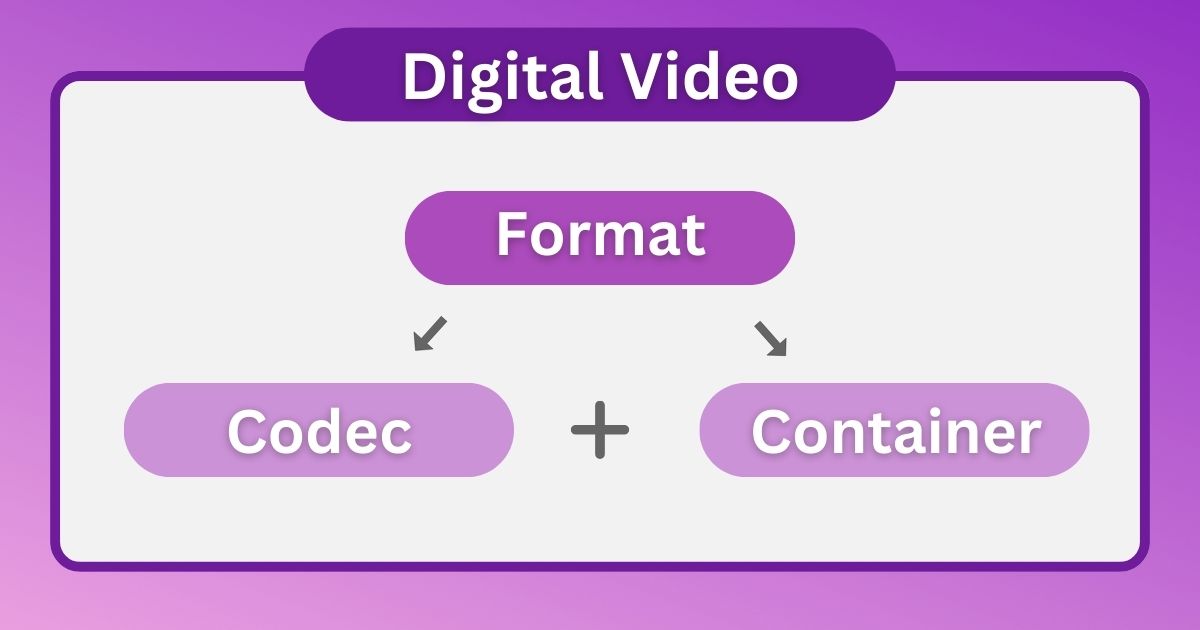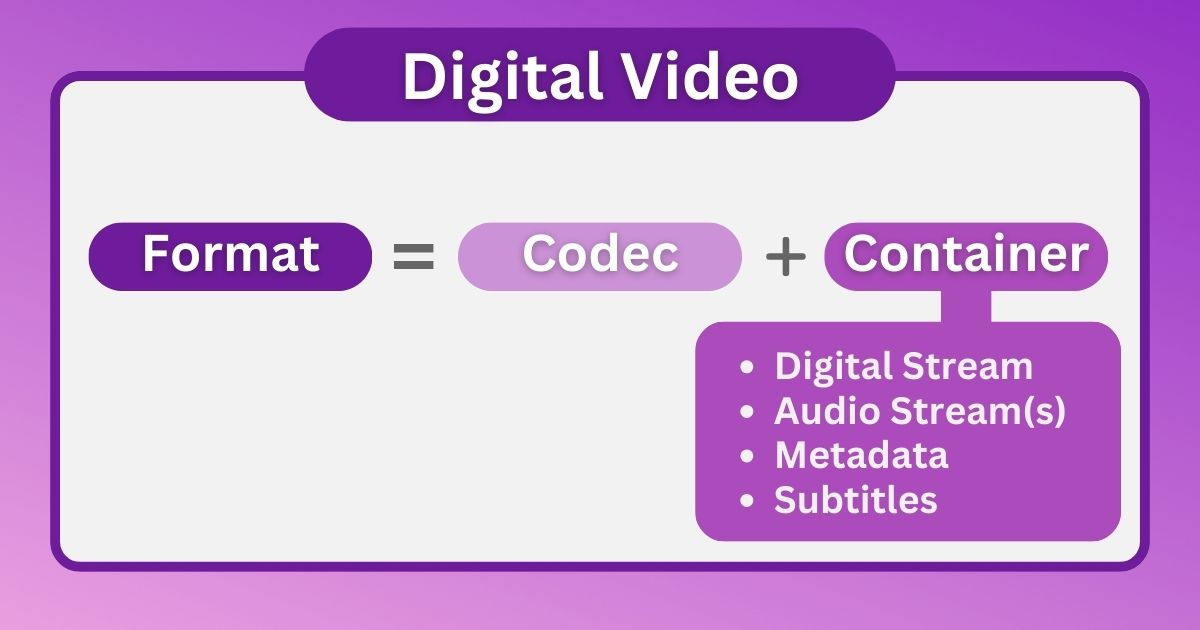
Understanding the intricate dance between formats, codecs, and containers is akin to unraveling a complex puzzle. In this article, we will shed light on these fundamental components, aiming to demystify the intricate tapestry of digital video.
Formats, Codecs & Containers
Digital video files can have many different file extensions - from the ubiquitous MP4 to the versatile MOV and the industrious MXF. However, contrary to common belief, the identity of a digital video format isn't confined within its file type.
Unlike the straightforward nature of image formats, where a JPG file is an image in a JPEG format, digital video formats are more complex. They are a combination of a video codec and a container.
Understanding Codecs and Containers
At the heart of every digital video format lies the codec - a technological maestro responsible for encoding and decoding video data. Standing for 'coder-decoder,' a codec employs intricate algorithms to compress and decompress video streams, ensuring efficient data transmission and storage.

In tandem with codecs, containers play a role in housing video streams and related content within a single digital enclosure. Think of containers as digital treasure chests, safeguarding video data and metadata while maintaining compatibility across various platforms and devices.
Most Common Codecs and Containers
Today, there are many different codecs and containers in use, with common codecs including:
- H.264 (AVC)
- H.265 (HEVC)
- H.262 (MPEG-2 Part 2): A stalwart in broadcast and DVD standards.
- M-JPEG
- ProRes
- DNxHD & DN&HR
Meanwhile, common containers include:
- MP4, AVI, MOV, MXF, 3DP & 3G2, MTS, M2TS & TS
Codecs
Imagine digital video as a sequence of still frames, akin to the classic reel of a movie film. At the core of this cinematic tapestry lies the codec. In essence, a codec is both the architect and the craftsman, digitally encoding and decoding these frames.
Codecs are versatile, employing sophisticated algorithms to compress video data and optimize file size. This compression, often achieved through intra-frame and interframe techniques, is essential for efficient storage and transmission.
Intra-frame Compression: Each frame is compressed individually, ensuring optimal quality and accessibility. Notable intra-frame codecs include MJPEG, ProRes, DNxHD, and DNxHR. These codecs prioritize quality and ease of editing, making them ideal for video production workflows.
Interframe Compression: Here, keyframes store complete frames, while delta frames capture incremental changes between them. Although interframe compression yields smaller file sizes, it sacrifices some quality and editing flexibility. Popular interframe codecs include H.264 (AVC), H.265 (HEVC), and H.262, each with its unique balance of quality and efficiency.
Digital Containers
Just as a treasure chest safeguards its riches, digital containers house video streams, audio tracks, subtitles, and accompanying metadata within a single entity.
MP4, AVI, and MOV are among the most common containers, offering versatility and compatibility across various platforms and devices.

MP4: Championed by the Motion Picture Experts Group (MPEG), MP4 stands as a versatile container widely embraced in both professional and consumer domains.
AVI: Developed by Microsoft, AVI (Audio Video Interleave) remains a cornerstone in digital video containers, renowned for its simplicity and widespread support.
MOV: Apple's brainchild, MOV (QuickTime Movie), embodies versatility and sophistication, catering to a myriad of multimedia needs.
Beyond the mainstream, niche containers like MXF, 3GP & 3G2, MTS, and M2TS & TS cater to specialized requirements in professional video production and distribution.
Video Formats: Where Codecs Meet Containers
Codecs and containers intertwine to create a multitude of video formats. From acquisition to delivery, these formats cater to diverse needs and preferences.
A few examples when it comes to acquisition:
AVCHD: A consumer favorite, AVCHD combines H.264 (interframe) codec with MTS or M2TS containers, offering high-definition video capture in a compact package.
XAVC: Sony's XAVC formats leverage the power of H.264 codec within MXF or MP4 containers, delivering pristine video quality in professional workflows.
XF-AVC: Canon's XF-AVC format mirrors this synergy, pairing H.264 codec with MXF containers for seamless integration into professional video production pipelines.
Example Digital Video Formats
Digital video formats often lack specific names, opting instead for a fusion of codecs and containers.
DSLRs, for instance, silently employ H.264 or H.265 codecs within MP4 or MOV containers, capturing moments without declaring a distinct format.
Similarly, cameras embracing the ProRes codec find solace in MOD containers, while DNxHD and DNxHR codecs gravitate towards MXF or MOV files.
Videos shot on smartphones also do not have a named format. They are usually encoded with an H.264 or H.265 codec and stored within a 3GP, 3G2, or MP4 container on an Android device. Or, in a MOV container on an iPhone.
Digital Video Delivery
When it comes to the delivery of final digital video files, the landscape shifts yet again. We often lack specific format names.
H.264 and H.265 codecs reign supreme within MP4 or MOV containers, offering a ubiquitous standard for consumer-grade content. Rendering your masterpiece with the H.264 codec and an MP4 container ensures compatibility and is the preferred upload format for platforms like YouTube.
The professional video delivery of final video files usually takes place in an MXF container using codecs that include ProRes, DNxHD, and DNxHR. Additionally, Panasonic's AVC-Intra codec is also common and it finds its niche, particularly in the realm of broadcast standards.
In Conclusion
For nearly a century, 35mm film was the go-to choice for filmmakers seeking stability and widespread acceptance. Despite technically being considered a container due to its adaptable nature, 35mm film offered versatility. However, today's landscape has dramatically shifted, with digital video taking center stage in online platforms, television, and cinemas alike.
As explored in this blog post, there is a wide range of codecs and containers available, which give us a diverse array of digital video formats. Deciding which format to use for shooting, editing, delivering, and archiving can be a tricky decision. We hope this discussion has provided some valuable insights to help navigate the complexities of digital video formats.

